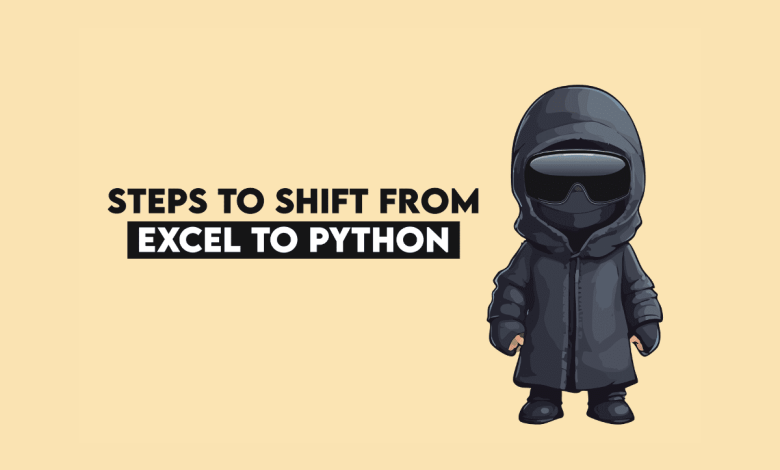From Excel to Python: 7 Steps to the Analyst Steps may take today


Photo by writer | Kanele
Obvious Introduction
Raise your hand when you start your data analyzes in Excel. Yup, too. Excel is a powerful tool for data analysis and visualization – and you can. Let's keep Excel funny comics in another article. However, despite advancement in handling large information, there is a point where Excel begins cream under load.
At this time, you may think, “Ah, Excel, I had to read Python.” You still know. (Read Python, not an Excel.) Also, to make that change means to get rid of properly. Think of the Python as the natural expansion of your skills, shown in these steps.


Obvious Step 1: Excel Excel Equality Skills Python
Excel skills transferred to Python, or is a planning language. You can think of “Excel outside the grid,” because more map is a map between two tools. Here are some examples.


While you will need to learn syntax reads and syntax languages and languages, you do not start at first – you are already understanding of work analytics. Now it is about doing Python what has happened in bold.
Obvious Step 2: Read Python Findamentals
Before you start installing codes, yourself practice them with basic language finances. I recommend starting with:
- Basic syntax
- Variable, data types, pebbles, conditions
- List and dictionaries (are the same as specified reasons or tables to look)
- Re-use code (they are like restored formulas in Excel)
Here are some resources to start:
Obvious Step 3: Set Your Nature
You do not need the complex Python. If you want to have it in your area, enter anacondo. It comes with the important libraries and libraries you will need at the beginning (Pandas, NEPY, and matplotlib). Including the writing documentation of Jussyter; Think about it as a worksheet where you write the code and the text notes.
You can make it very easy. If you have a Google Account, you can use the colle. It is the Google Noteer Notebook version and also come with more information installed than Anaconda.
Obvious Step 4: Start with panda
Python is famous for its nature, rich with libraries that give their abilities. One of them is pandas, library designed to analyze data and deception. More common in data analysis that can be separated by python itself; When you start learning Python, and you read the panda. Some things to practice are:
- Creating Datafrayes from Excel or CSV files
- Sorting, Sorting, Consolidation, Consolidation
- Repeating your best flow of Excel: Pivot tables, to look, a conditional calculation
Usually, try translating everything you do on Excel on the Python code.
Once you have received the Hang of Pandas, start using Inco, Brotherly Library Primary Increasing Pondas.
Obvious Step 5: Practice in real data
A quick way of learning about doing. There are several ways. You can solve the analysis questions in the stratascratch and leetcode and practice real discussion questions. You get information and the problem to solve; All you have to do is writing a cure in Python.
Another option is to use available datasets and resolve your thoughts. Some good sources of data Kaggle Datiseets, data.gov, and scary public detail.
If you need certain suggestions for solving problems, start with:
- Data cleaning (double-removing, normal days, filling out non-existing values)
- To create simple reports you usually do brightly
Obvious Step 6: Start visual data
The next step is to start to see about your analysis. A good start to reset the epython charts you already have with Excel. These two most popular Python documents are the information libraries are:
- Mattplict – basic sites (line, bar, spend)
- Saked – for the advanced sight with a small code
Obvious Step 7: Combine Excel Nython
You don't need to get rid of Excel. Even if you want, you couldn't because many participants were struggling.
The ideal combination to use Openpyxl or XWINGS to write back to Excel files from Python. In other words, Python lifts a lot in the back, but the last storage places are very good for participants. No need to stand there; Currently, Microsoft examines new Copilot work () the work that allows you to use AI on Excel.
Obvious Store
As you can see, conversion from Excel to Python does not mean that you start with zero. If you process data on Excel, that is already that you have basic information. You are able to your data analysis; The only thing to do is complexly complicated by transferring that information into the program.
Follow the steps in this article, and your change will be smooth than you think.
Nate Rosid He is a data scientist and product plan. He is a person who is an educated educator, and the Founder of Stratascratch, a stage that helps data scientists prepare their conversations with the highest discussion of the chat. Nate writes the latest stylies in the work market, offers chat advice, sharing data science projects, and covered everything SQL.



